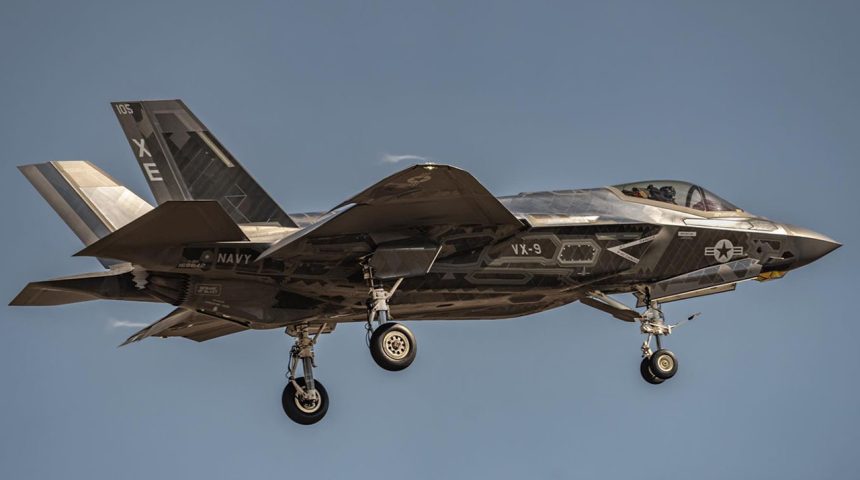The second “chrome” F-35C was photographed at Point Mugu recently.
A new F-35C, airframe BuNo 168842, Modex 105, sporting a mirror-like coating, was photographed last week while arriving at Naval Base Ventura County (NBVC) Point Mugu, California, adding to the one that was spotted earlier this year (XE-100) flying through the Sidewinder low-level route in the Sequoia National Park. Like the first one, the aircraft is assigned to the U.S. Navy’s Air Test and Evaluation Squadron Nine (VX-9) out of Naval Air Weapons Station China Lake.
View this post on Instagram
The new “chrome” F-35C had been already spotted at Edwards Air Force Base, California, in May, but the new photographs provide a better look at its peculiar coating.
WOW awesome shots!!! I think this is the same one I got last May at Edwards but was too far off to get the BuNo The number on the tail looks like its the same 105. pic.twitter.com/zDxE5TuOvb
— cvvhrn / FreddyB Aviation Photography 🇺🇦🇺🇦 (@cvvhrn) August 20, 2022
The F-35C XE-105 will apparently support multiple test events, as announced by the Navy in an aircraft advisory to the local population, where approximatively 50 aircraft will fly daily missions from August 22 to September 2. The Navy also says the purpose of this exercise is to provide unit-level training for pilots and aircrews on the Point Mugu Sea Range.
Interestingly, operating out of NBVC these days are also two F-117s.
View this post on Instagram
The F-35C XE-105 is only the latest of many aircraft to be seen with this new mirror-like coating, following two F-22 Raptor and a F-117 stealth fighters that have been spotted flying since November 2021. The layout of the F-35’s coating is similar to what was seen on the F-22, with what appear to be small, mirror-like tiles that have been extensively applied on the nose section, weapons bay doors, fuselage and also inner and outer face of the twin tails.
As for the F-22, the coating has been applied to not interfere with access panels, weapon bays, sensor and antenna areas, landing gear doors and so on. Also, it appears that this coating has been applied over the standard grey livery of the F-35C and they appearance changes depending on the angle on observation. The tiles have different dimensions and shapes, with some areas showing larger diamond-shaped tiles, while other area have smaller diamond or triangle-shaped tiles.
Many theories emerged about the origin of these coatings, but without any official confirmation. Here’s what we wrote about the second “chrome” F-22:
Once again, we don’t know what’s the reason for the new “Chrome” or “Mirror-like” coating: among the various theories, there is the possibility the aircraft is involved in testing activities related to counter-IRST (Infra Red Search & Track) technologies or targeting systems, or it acts as a testbed for some technology that will eventually made its way to the 6th generation aircraft. Since the delicate radar absorbent material on some Raptors shows signs of degradation, someone suggested it could be used by the U.S. Air Force for testing some kind of RAM replacement. However, early consensus seems to trend towards an experimental skin used to equip the aircraft with a passive laser defense system: mirror tiles might be used to deflect energy of low power laser systems directed towards the aircraft.
Whatever the reason for the new coating, the differences between the first and the second “Chrome” Raptor are pretty evident. It would be interesting to know whether the results of the early testing activity helped shaping the modifications embedded in the second mirrored F-22, although it is also reasonable that both were conceived in that exact way since the beginning. Who knows, maybe in the following months we will also see other “Chrome” Raptors emerge…
Referring to the F-22’s delicate RAM, which requires extensive maintenance to avoid a quick deterioration, there was the suggestion the U.S. Air Force is testing some kind of RAM replacement. Apparently, this appears to be the case, as it was kind of confirmed to The War Zone by Maj. Kevin Autrey, 422nd Test and Evaluation Squadron’s (TES) lead F-22 Raptor operational test pilot at Nellis Air Force Base.
Since the exotic “Chrome” F-22 have been spotted flying out of Nellis, while also taking part to in Weapons School Integration (WSINT) missions and Red Flag missions, the origin of the coatings was an obvious question during the interview. Maj. Autrey could only say that these are experimental solutions which are being tested to see if they make it easier to maintain the sustainability and reliability of the aircraft.
View this post on Instagram
This could very well be the same reason behind the F-35C’s new coatings. In fact, during the first operational deployments of the F-35C aboard aircraft carriers around the world, it has been noted that the RAM showed significant wear and tear in the demanding maritime environment, with what appeared to be rusty-looking deposit all across the aircraft.
Whatever, these new coatings are pretty interesting and we will continue to report about them as soon as we get additional details (or new ones emerge).
Once again, a big Thank You goes to @point_mugu_skies for allowing us to use the headline photo of the new chrome F-35. Make sure to follow him on Instagram for more amazing photographs!









